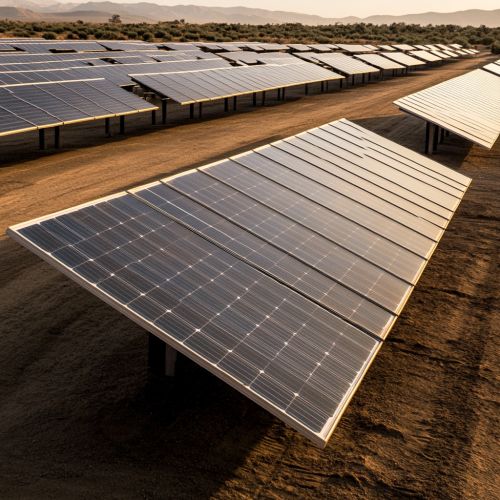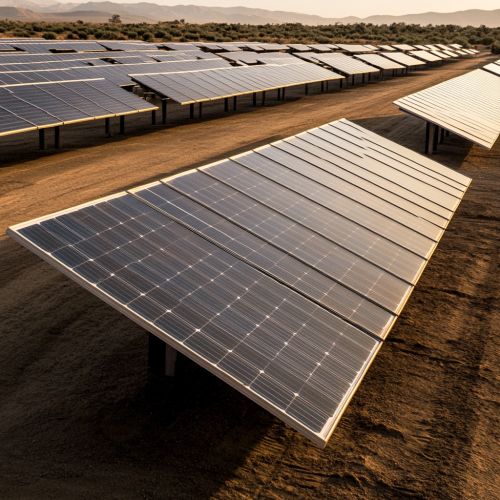Renewable energy in the United States: Difference between revisions
(Created page with "== Overview == Renewable energy in the United States encompasses a diverse array of energy sources that are naturally replenished on a human timescale. These include solar, wind, hydroelectric, geothermal, and biomass energy. The United States has made significant strides in the development and utilization of renewable energy technologies, driven by both environmental concerns and economic incentives. == Historical Context == The history of renewable energy in the Unite...") |
No edit summary |
||
| Line 14: | Line 14: | ||
Solar thermal systems use mirrors or lenses to concentrate sunlight and generate heat, which is then used to produce electricity. These systems are particularly effective in regions with high solar insolation. The Ivanpah Solar Power Facility in California is one of the largest solar thermal plants in the world. | Solar thermal systems use mirrors or lenses to concentrate sunlight and generate heat, which is then used to produce electricity. These systems are particularly effective in regions with high solar insolation. The Ivanpah Solar Power Facility in California is one of the largest solar thermal plants in the world. | ||
[[Image:Detail-97649.jpg|thumb|center|Rows of solar panels in a desert setting.|class=only_on_mobile]] | |||
[[Image:Detail-97650.jpg|thumb|center|Rows of solar panels in a desert setting.|class=only_on_desktop]] | |||
== Wind Energy == | == Wind Energy == | ||
Latest revision as of 23:47, 18 August 2024
Overview
Renewable energy in the United States encompasses a diverse array of energy sources that are naturally replenished on a human timescale. These include solar, wind, hydroelectric, geothermal, and biomass energy. The United States has made significant strides in the development and utilization of renewable energy technologies, driven by both environmental concerns and economic incentives.
Historical Context
The history of renewable energy in the United States dates back to the early 20th century, with the establishment of hydroelectric power plants. However, it wasn't until the 1970s, amidst the oil crises, that substantial investments were made in alternative energy sources. The Public Utility Regulatory Policies Act (PURPA) of 1978 was a pivotal moment, encouraging the development of renewable energy by requiring utilities to purchase power from independent producers.
Solar Energy
Solar energy harnesses the power of the sun through photovoltaic (PV) cells and solar thermal systems. The United States is one of the leading countries in solar energy production.
Photovoltaic Systems
Photovoltaic systems convert sunlight directly into electricity using semiconductor materials. The efficiency of PV cells has improved significantly over the years, with modern cells achieving efficiencies of over 20%. The cost of solar panels has also decreased dramatically, making solar energy more accessible.
Solar Thermal Systems
Solar thermal systems use mirrors or lenses to concentrate sunlight and generate heat, which is then used to produce electricity. These systems are particularly effective in regions with high solar insolation. The Ivanpah Solar Power Facility in California is one of the largest solar thermal plants in the world.


Wind Energy
Wind energy is generated by converting the kinetic energy of wind into mechanical power, which is then converted into electricity. The United States has vast wind resources, particularly in the Great Plains and offshore areas.
Onshore Wind Farms
Onshore wind farms are typically located in rural areas with high wind speeds. The state of Texas leads the nation in wind energy production, followed by Iowa and Oklahoma. The development of larger and more efficient wind turbines has significantly increased the capacity of onshore wind farms.
Offshore Wind Farms
Offshore wind farms are situated in bodies of water, where wind speeds are generally higher and more consistent. The Block Island Wind Farm, located off the coast of Rhode Island, was the first commercial offshore wind farm in the United States. The potential for offshore wind energy is immense, particularly along the East Coast and the Great Lakes.
Hydroelectric Power
Hydroelectric power is generated by harnessing the energy of flowing water. The United States has a long history of hydroelectric power generation, with significant infrastructure already in place.
Large-Scale Hydroelectric Plants
Large-scale hydroelectric plants, such as the Hoover Dam and the Grand Coulee Dam, have been instrumental in providing renewable energy for decades. These facilities generate electricity by releasing water from reservoirs through turbines.
Small-Scale and Micro-Hydro Systems
Small-scale and micro-hydro systems are increasingly being developed to provide power to remote areas. These systems have a lower environmental impact compared to large-scale hydroelectric plants and can be installed in smaller rivers and streams.
Geothermal Energy
Geothermal energy harnesses the heat from the Earth's interior to generate electricity and provide direct heating. The United States is a global leader in geothermal energy production, particularly in the western states.
Geothermal Power Plants
Geothermal power plants are typically located in regions with high geothermal activity, such as California, Nevada, and Hawaii. These plants use steam or hot water from underground reservoirs to drive turbines and generate electricity.
Direct Use Applications
Direct use applications of geothermal energy include heating buildings, greenhouses, and aquaculture facilities. Geothermal heat pumps are also used for residential and commercial heating and cooling.
Biomass Energy
Biomass energy is derived from organic materials, such as wood, agricultural residues, and animal waste. It can be used to produce electricity, heat, and biofuels.
Bioelectricity
Bioelectricity is generated by burning biomass in power plants or by converting it into biogas through anaerobic digestion. The United States has numerous biomass power plants, particularly in the Southeast, where there is an abundance of forestry and agricultural residues.
Biofuels
Biofuels, such as ethanol and biodiesel, are produced from crops like corn and soybeans. The Renewable Fuel Standard (RFS) mandates the blending of biofuels with gasoline and diesel, promoting the use of renewable energy in the transportation sector.
Policy and Regulation
The development of renewable energy in the United States is heavily influenced by federal, state, and local policies and regulations.
Federal Policies
Federal policies, such as tax credits, grants, and loan guarantees, have been crucial in supporting renewable energy projects. The Investment Tax Credit (ITC) and the Production Tax Credit (PTC) are two key incentives that have driven the growth of solar and wind energy, respectively.
State Policies
State-level policies, including Renewable Portfolio Standards (RPS) and net metering programs, have also played a significant role. RPS mandates require utilities to obtain a certain percentage of their electricity from renewable sources, while net metering allows consumers to receive credit for excess electricity generated by their renewable energy systems.
Economic Impact
The renewable energy sector has a significant economic impact in the United States, creating jobs and stimulating investment.
Job Creation
The renewable energy industry employs hundreds of thousands of workers in various roles, from manufacturing and installation to maintenance and research. The solar and wind energy sectors, in particular, have seen substantial job growth in recent years.
Investment and Market Trends
Investment in renewable energy projects has been robust, with billions of dollars flowing into the sector annually. Market trends indicate a continued shift towards renewable energy, driven by declining costs and increasing demand for clean energy.
Environmental Impact
Renewable energy sources have a lower environmental impact compared to fossil fuels, contributing to the reduction of greenhouse gas emissions and air pollution.
Greenhouse Gas Emissions
The use of renewable energy helps to mitigate climate change by reducing greenhouse gas emissions. Solar, wind, and hydroelectric power generate electricity without emitting carbon dioxide, while biomass energy can be carbon-neutral if managed sustainably.
Air and Water Quality
Renewable energy technologies generally have a minimal impact on air and water quality. Unlike fossil fuel power plants, they do not produce harmful pollutants such as sulfur dioxide, nitrogen oxides, and particulate matter.
Challenges and Future Prospects
Despite the progress made, there are several challenges to the widespread adoption of renewable energy in the United States.
Intermittency and Storage
One of the main challenges is the intermittency of renewable energy sources like solar and wind. Energy storage technologies, such as batteries and pumped hydro storage, are critical to addressing this issue and ensuring a reliable energy supply.
Grid Integration
Integrating renewable energy into the existing grid infrastructure poses technical and regulatory challenges. Upgrading the grid to accommodate distributed generation and implementing smart grid technologies are essential for the future growth of renewable energy.
Policy Uncertainty
Policy uncertainty at the federal and state levels can hinder the development of renewable energy projects. Stable and long-term policy frameworks are necessary to provide the confidence needed for continued investment in the sector.
See Also
- Energy policy of the United States
- Solar power in the United States
- Wind power in the United States
- Hydroelectric power in the United States
- Geothermal energy in the United States
- Biomass energy in the United States
